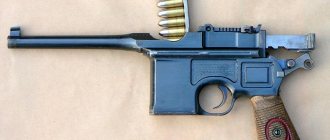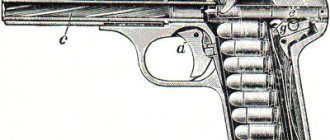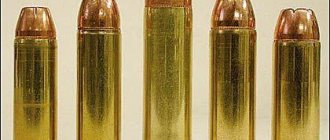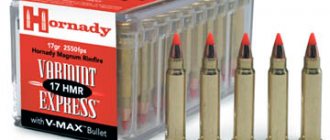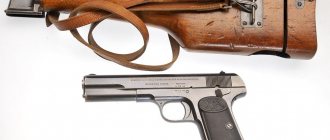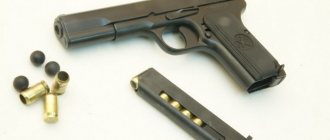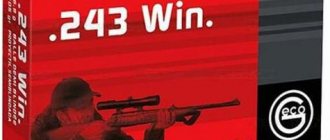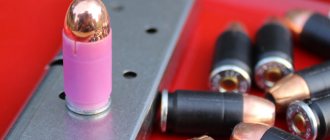Caliber history: 6.35 mm Browning
We tell the story of the creation of the Browning cartridge and its development in the USSR
From the point of view of most theories about the stopping effect of a bullet, the 6.35x15 mm cartridge, also known as the .25 ACP (Automatic Colt Pistol), is completely insufficient for action against a person. The caliber is small, the cartridge itself is weak - this can only stop a fighting hamster. But at one time, the popularity of this cartridge could be envied by many much more powerful brothers. Even the USSR was not spared its popularity.
In numerous westerns about the wild west, we are used to seeing cowboys with large revolvers: Colts, Remingtons, Smith & Wessons, as well as lever-action Winchesters. Or simply with double-barreled guns, a volley of which sends the villain out of the saloon doors to the other end of the street, along with his horse. Only occasionally do baby derringers or small small-caliber revolvers flash on the screen. Meanwhile, compact weapons were in great demand, even if many models were designed for completely “frivolous” calibers. For example, the history of Smith & Wesson began with the (S&W) Model 1 revolver chambered for the .22 Short cartridge - even weaker than the later .22 Long Rifle. This did not stop the first Smith & Wesson from selling about a quarter of a million guns, not counting numerous imitations. In the end, sharpers who wore “babies” behind the cuff of their sleeves along with marked cards, girls with reduced social responsibility and other consumers of such “toys” preferred ultra-short distances, and the barrel in front of their eyes looks convincing, regardless of the caliber.
When creating his line of pistols, John Moses Browning was fully aware of the prospects of the “kids” market - not even just pocket ones, but so-called “vest” models that can fit into a small and flat pocket. Typically, such weapons were created for the popular .22lr or .22 Short cartridges. But if in revolvers the rimfire cartridge with a rim worked perfectly, then for a pistol with its automatic operation it presented a big problem. Browning solved the problem in the simplest way - by creating a new cartridge with energy approximately equal to .22lr, but with a center-ignition primer, having both a groove at the base of the case and a small rim. The latter was supposed to ensure the most reliable extraction of the cartridge. The small size of the cartridge and relatively low power made it possible to create a simple, reliable and compact weapon for it. Another participant in the development of the new cartridge was William Morgan Thomas from the Union Metallic Cartridge Company (UMC). The result was the appearance of the 6.35x15 mm cartridge and the FN Browning Model 1906 pistol.
The popularity of this miniature pistol can hardly be described as anything other than “mad.” Fabrique Nationale alone produced more than a million M1906s before the early 30s. Then it was replaced by an even smaller FN Baby Browning - a variant of the M1906, modified by Didien Sav, the future co-author of the Browning High-Power pistol and creator of the FN FAL rifle. The Baby Browning was produced at FN until 1979. The cessation of production was caused not so much by the decline in demand as by legal subtleties. After the assassination of Robert Kennedy (by the way, with a .22lr revolver), the United States adopted the so-called Gun Control Act, which prohibited, among other things, the import of Belgian babies. But this legislation did not prohibit the sale of pistols made in North America, so with the financial and technological support of FN, Baby Browning production was launched first in Canada and then in the USA. However, the popularity of the 6.35 mm cartridge was far from limited to Brownings - many models were created for it from well-known companies: Beretta 1919, Haenel Schmeisser Modell I, Walther Model 1, vz 21 Praga and others.
Separately, it is worth mentioning the fate of Browning’s cartridge in the USSR. After the civil war, the population, often not even the most ordinary citizens, was left with a mass of different “vests” chambered for this cartridge. The need for a pocket pistol was quite obvious - a standard revolver, even in the version with a shortened barrel for concealed carry, especially in summer, did not fit very well. And so, in 1925, the Dynamo sports society ordered the development of a compact pistol for 6.35x15 mm from the Tula Arms Plant. The development was entrusted to Sergei Aleksandrovich Korovin, clearly “with an eye” on his pre-revolutionary work experience in Belgium, at the same Fabrique Nationale, which implied close acquaintance with the features of Browning pistols. Already in the next 1926, a new pistol, called TK - Tula Korovin - began to be produced at TOZ-e. In general, the Tula Korovin looked like a completely classic “vest” - blowback automatic, small dimensions and weight, a minimum of protruding parts, a single-row magazine with a fixed latch.
A number of sources indicate that the pistol was not adopted by the army. We can say for sure that some of the issued “cows” went to the senior command staff of the Red Army. However, civilian authorities and party workers also loved small and light pistols. One TK was also made for Comrade Stalin, who did not neglect personal weapons, but, according to the recollections of the guards, it was a Mauser M1910, also chambered for 6.35 mm. It was this kind of Mauser that Arkady Gaidar wrote about in his story “School”:
«The Mauser was small, comfortable, in a soft suede holster.”
In total, judging by the known numbers, about half a million TKs were produced.
In the first half of the 30s, the production of cartridges was also launched for the TK. Moreover, the data for .25 ACP was obtained using the reverse engineering method, having repeatedly measured the available cartridges from foreign companies. It should be noted that in the documents studied by the author, information about the supposedly greater power of Soviet cartridges for TK has not yet been confirmed. Considering that packs of Soviet-made cartridges were labeled “cartridges for a Browning pistol cal. 6.35,” it is doubtful that they had a larger charge, with which their use in other pistols would become dangerous. Perhaps the reason for the appearance of such information about a more powerful cartridge was the development of bullets with a steel core for the TK, which could actually provide some increase in penetration.
To summarize, we can say that, of course, 6.35x15 mm is not a real “stopper” that can stop any bruiser even if it hits the left heel. Moreover, there are many stories of how attackers under the influence of adrenaline or other substances simply did not notice even multiple hits of 6.35x15 mm. Nevertheless, even a small gun is often better than no gun at all - as US practice shows, the fact that the victim has a weapon is a sufficient argument for the criminal to stop the attack.
Agility test. Cartridge 6.35 mm Browning
The 6.35 mm Browning cartridge is rarely loaded by hand. This is primarily due to the low consumption of ammunition intended for small-sized pistols. In this regard, the provision of components for re-equipment in some cases can be called unsatisfactory. In addition, the process of equipping these small cartridges can be attributed to painstaking work.
Along with the 7.65 mm Browning cartridge, the 6.35 mm Browning cartridge is perhaps the best known, used in shooting small pistols, often called "ladies" or "vest". We can say that in modern weapons these “tiny things” have practically ceased to play any noticeable role. However, in the first decades of the twentieth century, the situation was completely different. At that time, there was a huge market for small-sized pistols on both sides of the Atlantic, and their supply was simply endless. It included both cheap weapons and high-quality models, which, for example, were produced by Colt, FN (Fabrique Nationale) and Walther. The 6.35 mm Browning cartridge was used by both private individuals and government agencies such as the police and army. Pistols for officers chambered for the 6.35 mm Browning cartridge were especially popular. They were partially used as auxiliary weapons. German criminal police officers continued to use small-caliber small-sized pistols as service weapons until the early 1970s. They, like the pistols chambered for 7.65 mm Browning, which became the service weapon of the German police, were withdrawn from service only in the 1970s. The reason for this was the new requirement for a strong stopping effect of bullets, which was provided by pistols chambered for the 9 mm Luger cartridge. Success in the civilian sector was primarily due to easier legal requirements for purchasing and carrying weapons. These small-sized pistols could be carried unnoticed in a vest pocket in the truest sense of the word. Women carried small pistols in their purses. In certain circles, stocking garters were used as holsters. Of course, from a modern point of view, the 6.35 mm Browning cartridge, originally equipped with a full-jacket bullet weighing 50 grains (3.2 g), is of little use in terms of use for defensive purposes. However, many people prefer to assume that in a critical situation it is better to have an FN Baby rimfire pistol in your hand than an M1911A1 Colt Government .45 caliber pistol in a drawer at home.
Guaranteed supply
Most pistol cartridge manufacturers offer a wide variety of components to load the 6.35 mm Browning cartridge, also known as .25 Auto or .25 ACP. This is due to the significant number of small-bore pistols in personal ownership, as well as the huge supply of used weapons. To improve the ballistic characteristics of the 6.35 mm Browning cartridge in recent years, light hollow-point bullets have been used, which have been re-authorized in Germany since 2003. Of course, this completely reasonable decision, which affects the stopping effect of a bullet, is just a drop in the bucket. The initial energy of the bullet, ranging from 70 J to 100 J, is clearly insufficient for service weapons used for self-defense, at least for pistols chambered for 6.35 mm Browning. This ammunition also cannot be used in hunting to finish off large game.
Famous surnames
Based on the name of the 6.35 mm Browning cartridge, it can be assumed that its origin is somehow connected with weapons designer John Moses Browning, who at the beginning of the twentieth century designed small-sized pistols for the FN and Colt companies that became very popular.
The 6.35 mm Browning cartridge was created in collaboration with FN in 1904–1905. The victorious march of the cartridge around the world began with the Model 1906 pistol developed by Browning for the same company, which should be considered as the prototype of all small-caliber small-sized pistols. This weapon is a greatly reduced version of the FN 1903 pistol. The magazine capacity of the FN Model 1906 pistol is six rounds, and its loaded weight is only 375 g. In the mid-1930s, the FN Model 1906 pistol was replaced by the Baby model, also chambered for 6 cartridges, 35 mm Browning.
Impressed by the success of the small-sized Browning pistol chambered for the 6.35 mm Browning cartridge from the Belgian manufacturer Fabrique Nationale, Colt also introduced its Hammerless .25 model to the arms market in 1908. It was also called Pocket 25 and was produced by Colt for 33 years. A total of 409,061 units of this model were produced.
Due to the fact that the pistols of the Colt and FN companies were very similar, a number of agreements were concluded between the manufacturers Colt, FN and the designer Browning, according to which the North American market was assigned to Colt and the European market to FN. The remaining markets were available to both manufacturers. In addition to vest pistols, some other slightly larger models were also chambered for the 6.35 mm Browning cartridge, such as the Walther PPK, which, of course, were more convenient to handle and allowed for more accurate shooting.
Due to the fact that the 6.35 mm Browning cartridge is not suitable for sport shooting or hunting, it is rarely used in shooting ranges in Germany. As a rule, these cartridges are used only for shooting from small-sized pistols that have been owned by individual shooters for quite some time. Thus, the 6.35 mm Browning cartridge plays a minor role in the family of self-loading pistols. Due to low consumption, most shooters use factory-made cartridges, which are available in a fairly wide range on the market. In the first decades of the twentieth century, the 6.35 mm Browning HR cartridge (with a semi-protruding rim) was also used for firing from revolvers. Such revolvers were produced in limited quantities by small arms companies in Spain and Belgium. But even in the German city of gunsmiths Sule, a limited number of revolvers chambered for the 6.35 mm Browning cartridge were produced. This weapon failed to gain popularity and was soon completely forgotten.
Hand equipment
When automatically reloading a weapon, there is one problem associated, like with large-caliber cartridges, with the pressure of the powder gases. Due to the large number of models available that are of poor quality, caution should be used when shooting 6.35mm Browning cartridges. Therefore, ammunition manufacturers, such as Geco, load their cartridges very carefully. However, as with full-size pistols, in some cases, cartridges can be loaded manually to slightly improve ballistic characteristics. In this case, the powder charge should be slightly increased, taking into account that this will not lead to exceeding the permissible maximum pressure of the powder gases.
The main reason the 6.35mm Browning cartridge is rarely handloaded is its size. Handling a hand or tabletop screw and loading a small powder charge requires finger dexterity. For example, the author would rather load 500 rounds of .38 Special ammunition than 50 rounds of 6.35 mm Browning ammunition. This small cartridge has virtually no reserve for improved ballistic performance. The goal assigned to him can be considered achieved in the absence of delays and exceeding the maximum pressure of the powder gases. Accuracy training with vest pistols is also excluded. As practice has shown, they are fired from a distance of less than three meters.
The necessary set of matrices for hand-held equipment is supplied by well-known manufacturers. The author used a kit from RCBS. The supply of necessary components can generally be called satisfactory. At the same time, low demand has led to the fact that specialized and wholesale stores store them in warehouses in very limited quantities. As practice shows, when ordering components for hand-loading 6.35 mm Browning cartridges, you should expect long delivery times. If you do not use spent factory-made cartridge cases for reloading, you can purchase them. For example, Magtech sleeves are available for sale. Unfortunately, most manufacturers do not sell 6.35 mm Browning cartridge cases. This is due to low demand.
As for powders, only pistol powders with a high burning rate should be considered for loading the 6.35 mm Browning cartridge. During test firing, DWJ magazine staff obtained good results using Rottweil P 801, Rottweil P 805, Alliant Red Dot and IMR 700-X powders. Alternatively, Alliant Bullseye, Hodgdon TiteGroup, and Winchester 231 powders can be used. When loading, it is recommended to use a standard Small Pistol primer. Due to the small powder charge, the volume of powder should be weighed when loading each cartridge. This is due to the fact that conventional powder dispensers have very large errors. Before loading with a powder charge, it is recommended that small cartridges be placed on a suitable charging board. In short, handloading the 6.35mm Browning is a very good workout in perseverance.
DWJ findings
The 6.35 mm Browning pistol cartridge, very popular in the first decades of the twentieth century, is known for its very low performance when used in self-defense weapons. As a result, its importance began to wane in the 1970s. At the same time, only a few shooters are willing to manually load small-sized cartridges, which requires painstaking work. The small sleeve does not allow you to experiment with equipment options. In the manufacture of cartridges, the main attention is paid to the reliable operation of the automation of the corresponding small-sized weapons. The permission to use expansion bullets in Germany (since 2003) has not significantly increased the interest of German shooters in the 6.35 mm Browning cartridge.
Hans J. Heigel, translation by Victor Nazarov
Encyclopedia of weapons
Cartridge 6.35x15.5 HR (6.35 Browning) / .25 ACP / 6.35 TK, 1906, USA
Tactical and technical characteristics of 6.35 mm Browning
Caliber - 6.35 Cartridge length, mm - 23.8 Weight, g - 5.3 Bullet weight, g - 3.25 Powder charge weight, g - 0.09 Initial bullet velocity, m/s - 230-247 Muzzle energy, J - 92
The 6.35x15.5 mm caliber cartridge was developed by John Moses Browning in 1906 for the FN Browning Model 1906 pocket small pistol.
The letters “HR” mean that the sleeve has a slightly protruding rim (or a slightly protruding flange) in combination with a groove (half-rim (English), halb-rand (German)). The cartridge has a generally accepted designation - “6.35 × 15.5 HR”.
Cartridge 6.35x15.5
It became widespread among civilian self-defense weapons at the beginning of the 20th century.
In the middle of the 20th century, a large number of models of pocket-type pistols for self-defense were created for it, some of them are still being produced. An example of this is pistols from the company S. Walther, models “TRN”, “RRK” or from the company R. Beretta, models “950”, “21” and many others.
After the start of production of the Colt 1908 pistol (American copy of the FN Browning model 1906), production of the 6.35x15.5 HR cartridge began in America under the name .25 ACP (Automatic Colt Pistol).
In addition to Colt, the cartridge was also produced by the American company Union Metallic Cartridge (UMC, a division of Remington).
The 6.35x15.5 cartridge has a cylindrical sleeve with a slight taper towards the barrel. The bullet is a shell bullet with a lead core. The bullet casing is copper or tombak, clad with cupronickel. The sleeve is brass.
In 1926, the S.A. pistol was adopted by the senior command staff of the Red Army of the USSR. Cow model "" chambered for 6.35 mm caliber.
However, the 6.35 caliber cartridge for the TK pistol was slightly different from the 6.35 Browning cartridge. The main differences consisted of a slight increase in the powder charge, bullet mass and cartridge length.
At the same time, the diameter of the case flange of the European cartridge was slightly larger. The 6.35 caliber cartridge used in the TK pistol was designated 6.35 TK and was produced until the mid-1960s.
The 6.35x15.5 caliber cartridge is used exclusively in miniature “ladies’” pistols. It has an extremely low stopping power and bullet penetration (often does not penetrate human cranial bones).
A bullet fired from a pocket automatic pistol has a speed of just over 200 m/s. In order to stop a well-prepared and ready-to-fight enemy, this is not enough; for this it is necessary to at least hit the vital organs.
This is almost impossible with a 6.35 mm caliber weapon in an extreme situation, at its maximum distances (over 10 meters). Caliber 6.35 mm. It has long been recognized by all experts as so ineffective that the use of such weapons is not recommended even for the purposes of self-defense as a “weapon of a second chance.”
‹ Cartridge 6 PPC Up Cartridge 6.5×51 Arisaka ›
